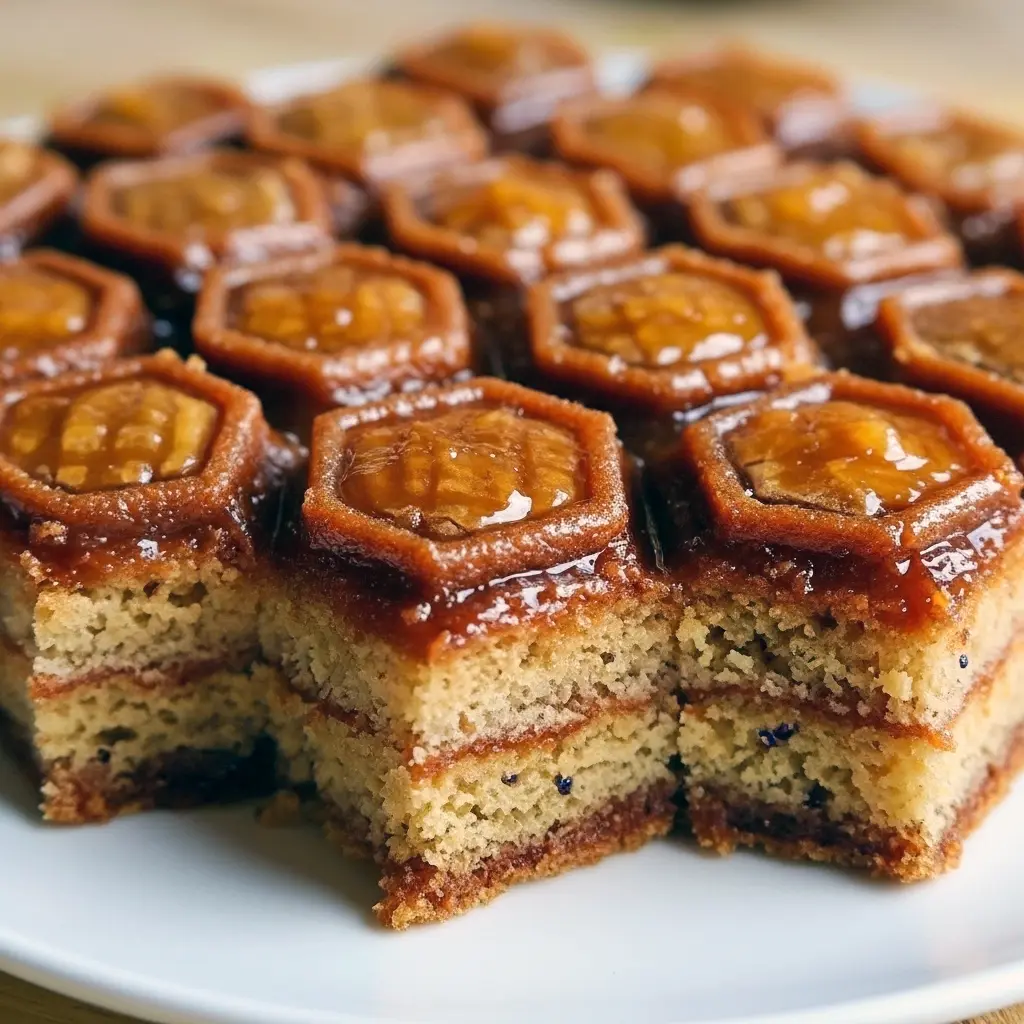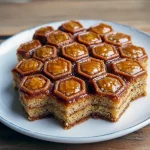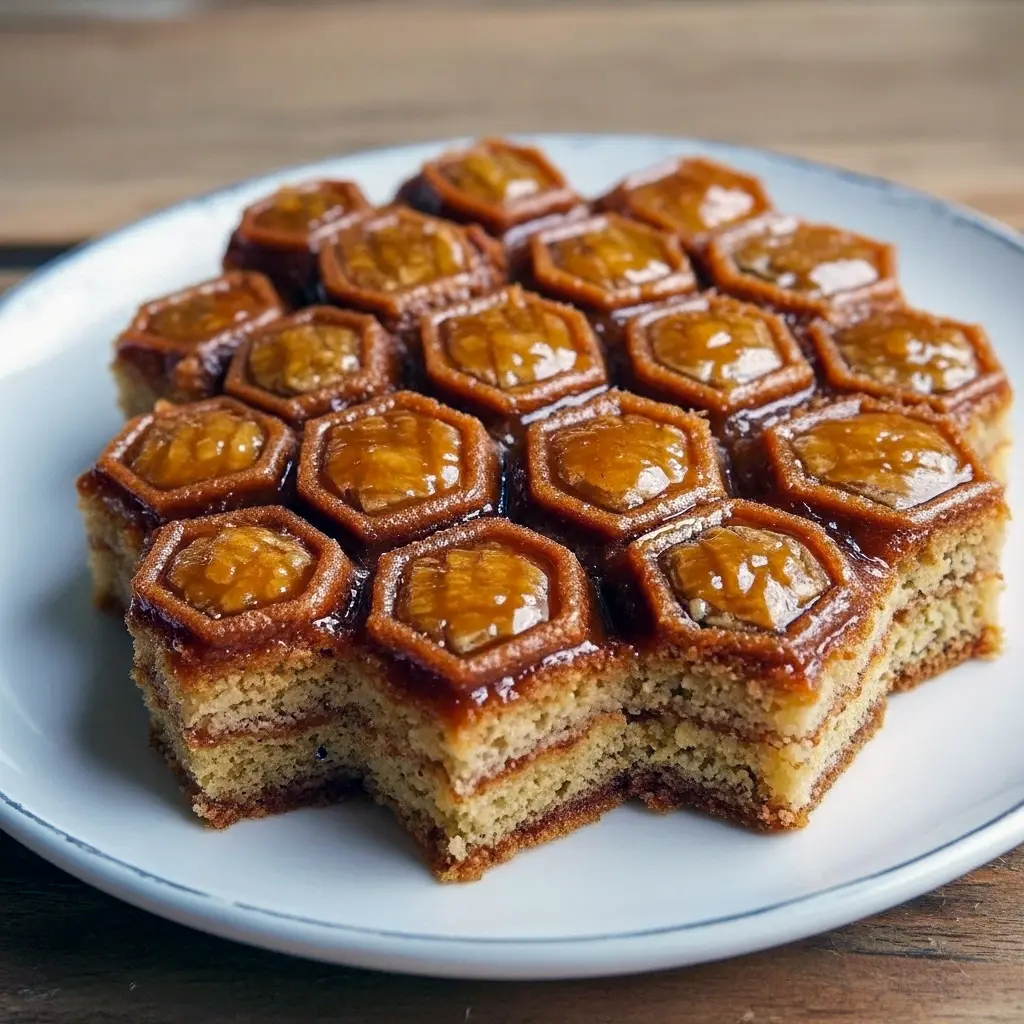Easy Honey Dessert — this Greek Honey Cake (Melopita) is the kind of dessert that smells like sunshine and tastes like a holiday. It soaks up a fragrant honey syrup, stays unbelievably moist, and somehow manages to be both indulgent and humble at once. Ready to make something glorious?
Introduction to the recipe
This Greek Honey Cake — a soft, olive-oil-and-yogurt sponge drenched in a lemony, spiced honey syrup — ranks high among Old Desserts that never go out of style. It feels rustic, but plated right it also fits menus for modern Restaurant Dessert Recipes. Think honey, citrus, warm spices, and a cake that drinks that syrup like a champ. Want a dessert that tastes like a dream and requires zero fancy technique? That’s this one.
What makes this recipe so irresistible?
Why do we keep coming back to syrup-soaked cakes across cultures? Because Desserts Using Honey deliver layered flavor—flowered sweetness, a hint of acidity, and a sticky, satisfying finish. This cake’s charm comes from three things:
- Texture contrast: a tender crumb dotted with citrus zest, plus a syrup that makes the cake luxuriously sticky.
- Aromatic depth: olive oil and Greek thyme honey add floral and savory notes you won’t get from plain sugar.
- Simplicity that sings: basic pantry ingredients, but the syrup technique turns them into something that tastes like a Dream Dessert.
Bold tip: Use a high-quality honey (Greek thyme or orange-blossom are ideal). The honey makes the cake, not just sweetens it.
Ingredients (short descriptions)
- 2 cups all-purpose flour — your structure.
- 1½ tsp baking powder + ½ tsp baking soda — lifts the batter just enough.
- ¼ tsp ground cloves + 1 tsp cinnamon — warm spice backbone.
- ½ tsp salt — balances sweetness.
- 1 cup granulated sugar — for the batter; syrup adds more sweetness.
- ½ cup extra virgin olive oil — keeps the cake moist and adds Mediterranean flavor.
- 2 large eggs — bind and enrich.
- 1 cup full-fat Greek yogurt — gives tenderness and tang.
- 1 tsp vanilla extract — aroma that rounds out the honey.
- Zest of 1 orange + 1 lemon — fresh citrus lift.
- For the syrup: 1 cup water, ¾ cup sugar, ¾ cup honey, cinnamon stick, cloves, citrus peels, 1 tbsp lemon juice — this is the magic soak.
Short note: olive oil + yogurt = moist crumb; the syrup does the rest.
Simple how-to (a straightforward method)
- Make the syrup first and cool it completely. Simmer water, sugar, spices, citrus peels; remove from heat and stir in honey and lemon juice. Strain and chill. Cool syrup on hot cake = best absorption.
- Preheat your oven to 350°F (175°C). Grease a 9×9 or 9-inch round pan.
- Mix dry ingredients in one bowl; whisk flour, baking powder, soda, salt, and spices.
- Combine sugar and zest, rubbing zest into sugar to release oils. Add oil and whisk.
- Add eggs and yogurt, mix until smooth, then fold in dry ingredients until just combined. Don’t overmix.
- Bake 35–45 minutes until golden and a toothpick comes out clean.
- Poke holes in hot cake and pour the cooled syrup slowly over the surface. Let it sit uncovered for at least 2 hours (overnight is better).
- Serve with chopped nuts, a dusting of cinnamon, or a spoonful of Greek yogurt.
Bold tip: Poke holes with a skewer so the syrup can fully penetrate the cake. This step is non-negotiable.
The story behind the recipe
Melopita and similar honey cakes are part of a long tradition across the Mediterranean and Near East where honey was the original sweetener. In Greece, honey cakes tie to feasts, monasteries, and home baking. They’re humble—no need for butter-heavy frostings—but they taste like celebration. That austere-plus-luxe combination is exactly why chefs list these among Unique Dessert Flavors on seasonal menus.
Pro tips for the best outcome
- Drain and room-temp ingredients: use room-temperature eggs and yogurt for a smooth batter.
- Zest the sugar: rub zest into sugar with your fingers—this releases essential oils and amps aroma.
- Quality honey: whatever you buy, avoid ultra-cheap, ultra-processed honey—its flavor will disappoint.
- Syrup temp rule: pour cooled syrup over hot cake (or warm syrup over cold cake). Both ways create a temperature contrast that helps absorption. I prefer cooled syrup right out of the pot over the hot cake.
- Patience: let the cake rest uncovered while it soaks; covering traps steam and dilutes the syrup’s intensity.
- Test early: Ovens vary—check a few minutes before the recommended bake time.
Bold tip: This cake tastes even better the next day—do not skip the overnight rest if you can help it.
Variations to try (explore other versions)
- Citrus-honey twist: boost the orange zest, use orange blossom honey, and scatter candied orange peel on top.
- Nut-studded: fold chopped walnuts or pistachios into the batter or sprinkle over the syrup-soaked top—classic.
- Chocolate-honey: swirl a few tablespoons of melted dark chocolate into the batter before baking for a surprising riff.
- Icelandic-inspired: for a playful nod to Icelandic Desserts, add a hint of cardamom and serve with skyr (Icelandic yogurt).
- Dairy-free: swap Greek yogurt with coconut yogurt and use neutral oil if you want a dairy-free cake.
- Mini versions: make muffins and reduce bake time; syrup absorption still works but monitor closely.
Want to call this an Insane Dessert for a dinner party? Try the walnut-and-citrus combo with a scoop of vanilla ice cream.

Best way to serve (pairings & plating)
- Classic: a wedge with a generous spoon of Greek yogurt. The tartness balances the syrup.
- A la mode: warm slice + vanilla bean or salted caramel ice cream. Textures: warm-syrupy vs cold-cream = heaven.
- Coffee time: serve with an espresso or robust black tea—perfect companion.
- Restaurant-style: plate a neat square, scatter crushed pistachios, drizzle a little extra honey, and add micro-mint for color. That presentation lifts it to Restaurant Dessert Recipes territory.
Quick tips for storage & leftovers
- Room temperature in airtight container: up to 5 days. This cake improves as flavors meld—no refrigeration needed.
- Freeze slices individually wrapped for up to 3 months. Thaw at room temp; warm gently if you prefer it hot.
- Reheat gently in a low oven or microwave; add a sprinkle of fresh syrup if the cake seems dry.
Nutrition & calories (brief)
A generous slice of this cake is indulgent—expect around ~380 calories per serving if you cut into 12 pieces, with Cakes With Honey naturally containing sugars from both sugar and honey. If you’re counting Cookie Calories—oh wait, wrong dessert—but yes, portion control matters. Tip: serve smaller slices with a spoonful of unsweetened yogurt to make the portion feel satisfying.
FAQs (quick answers)
Q: Can I make this gluten-free?
A: Yes—substitute a 1:1 gluten-free flour blend (with xanthan gum). Texture will vary but syrup keeps it moist.
Q: My cake came out dry—why?
A: Likely overbaked or insufficient syrup absorption. Ensure you pour the full, cooled syrup over a hot cake and let it rest.
Q: Can I use a different sweetener or less sugar?
A: You can reduce the batter sugar slightly, but the syrup’s sweetness defines the profile. If you reduce sugar, balance with a slightly stronger honey or more syrup.
Q: Is this similar to baklava?
A: Both use honey syrup, but baklava is phyllo + nuts; this is a sponge cake soaked in syrup—same family of syruped desserts, different textures.
Q: How long must the syrup cool?
A: Until it reaches room temperature. Warm syrup will evaporate more and may make the cake soggy; cold syrup won’t penetrate as well.
Final thoughts — why you’ll want to bake this
If you love Desserts Using Honey or are exploring Unique Dessert Flavors, this Greek Honey Cake is a must. It’s simple enough for beginners, flexible for creative cooks, and reliably delicious. It counts as an Easy Honey Dessert in my book—no complicated pastry work, just good ingredients and a little patience while it absorbs the syrup. Make it for a casual afternoon treat, bring it to a potluck, or add it to a dinner-party menu as a slightly unexpected sweet that everyone asks about. It’s both an Old Desserts classic and a candidate for being listed under Insane Desserts when paired with whipped cream or a rich gelato.
Ready to bake? Remember: the honey you choose and the patience you show while the cake soaks are the two things that turn a good cake into a great one. Happy baking—and if someone asks for the recipe, smile and say, “It’s a family secret,” then send them this link. 😉 (FYI: sharing is caring.)
Print
Crowd-pleasing Easy Honey Dessert — Greek Honey Cake, No Fuss
- Prep Time: 20 minutes
- Cook Time: 40 minutes
- Total Time: 1 hour
- Yield: 12 servings 1x
- Category: Dessert
Description
This Greek Honey Cake is a slice of pure Mediterranean comfort — rich, tender, and glowing with the natural sweetness of honey and olive oil. It’s a dessert that feels indulgent but still wholesome, thanks to its simple, nourishing ingredients. Each bite bursts with citrus, spice, and floral honey notes that get even better as it rests.
Cut into 12 slices, it offers a satisfying dose of energy from natural carbs, plus a little protein from the eggs and creamy yogurt.
The best part? It’s an easy, mostly hands-off recipe — perfect for home bakers who want impressive flavor without complicated steps. The key to perfection? Letting that golden honey syrup fully soak in. Patience makes magic here.
Ingredients
For the Cake
- 2 cups all-purpose flour
- 1½ tsp baking powder
- ½ tsp baking soda
- 1 tsp ground cinnamon
- ¼ tsp ground cloves
- ½ tsp salt
- 1 cup granulated sugar
- ½ cup extra virgin olive oil
- 2 large eggs, room temperature
- 1 cup full-fat Greek yogurt, room temperature
- 1 tsp pure vanilla extract
- Zest of 1 orange
- Zest of 1 lemon
For the Honey Syrup
- 1 cup water
- ¾ cup granulated sugar
- ¾ cup high-quality honey (Greek thyme or orange blossom is perfection)
- 1 cinnamon stick
- 3–4 whole cloves
- 2-inch strip orange peel
- 2-inch strip lemon peel
- 1 tbsp fresh lemon juice
Optional Garnish
- Crushed walnuts or pistachios
- A light dusting of ground cinnamon
Instructions
Begin here so it has time to cool before you pour it on the cake.
In a medium saucepan, add water, sugar, cinnamon stick, cloves, and both citrus peels. Bring it to a gentle boil, stirring until the sugar dissolves completely. Lower the heat and simmer for about 10 minutes, letting the spices and peels release their aroma.
Remove from heat, stir in the honey and lemon juice until the honey melts smoothly. Strain out the solids and set the syrup aside to cool completely.
Preheat your oven to 350°F (175°C). Lightly oil or butter a 9×9-inch square pan (or a 9-inch round pan) and dust with flour, tapping out any extra. This keeps the cake from sticking.
In a large bowl, whisk together the flour, baking powder, baking soda, cinnamon, cloves, and salt. A quick sift helps the cake bake up lighter and lump-free.
In a separate bowl, combine the sugar with both zests. Rub them together with your fingertips until fragrant — this step releases the citrus oils, giving your cake a bright, natural perfume.
Add the olive oil and whisk until fully blended.
Crack in the eggs one at a time, whisking after each until smooth and creamy. Then add the Greek yogurt and vanilla extract, whisking just until the batter is glossy and uniform.
(Room-temperature ingredients make all the difference — no curdled batter here!)
Tip the dry ingredients into the wet mixture. Gently fold together with a spatula until no dry streaks remain. Don’t overmix — that’s the fast track to a dense cake. A few small lumps are perfectly fine.
Pour the batter into your prepared pan, spreading it evenly. Bake for 35–45 minutes, or until the top is deep golden and a toothpick inserted in the center comes out clean.
Right after removing the cake from the oven, grab a skewer or fork and poke small holes all over the top. Slowly drizzle the cooled honey syrup over the hot cake, a little at a time. It will look like too much, but trust the process — the sponge will absorb every drop.
Leave the cake uncovered at room temperature for at least 2 hours, though overnight is even better. This allows the syrup to seep in completely, giving that tender, melt-in-your-mouth texture.
When the cake is fully soaked and cooled, top it with crushed nuts or a dusting of cinnamon for extra flair. Slice into neat squares or wedges and serve as is, or pair with a spoonful of Greek yogurt for a cozy, balanced dessert.
Notes
💡 Tips for the Best Greek Honey Cake
- Cool syrup + hot cake = perfect absorption. Don’t mix up the temperatures!
- Use real honey — cheap blends can dull the flavor.
- Don’t cover the cake while soaking. Moisture needs to evaporate slowly for the perfect sticky texture.
- Even better the next day — this cake ages like fine wine (or good olive oil).
Nutrition
- Serving Size: 1 serving
- Calories: 380 kcal
- Sugar: 35g
- Sodium: 250mg
- Fat: 15g
- Saturated Fat: 2.5g
- Carbohydrates: 58g
- Fiber: 1g
- Protein: 5g



